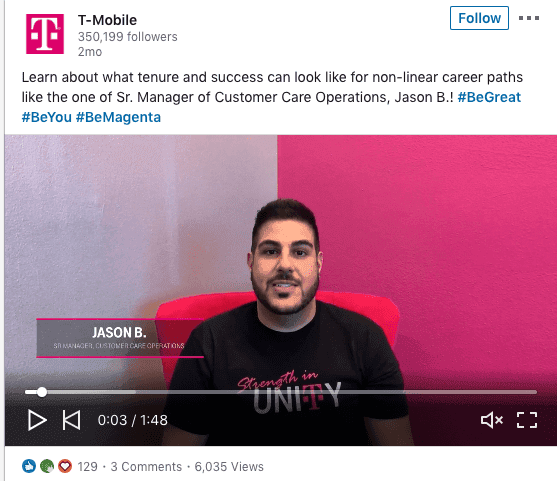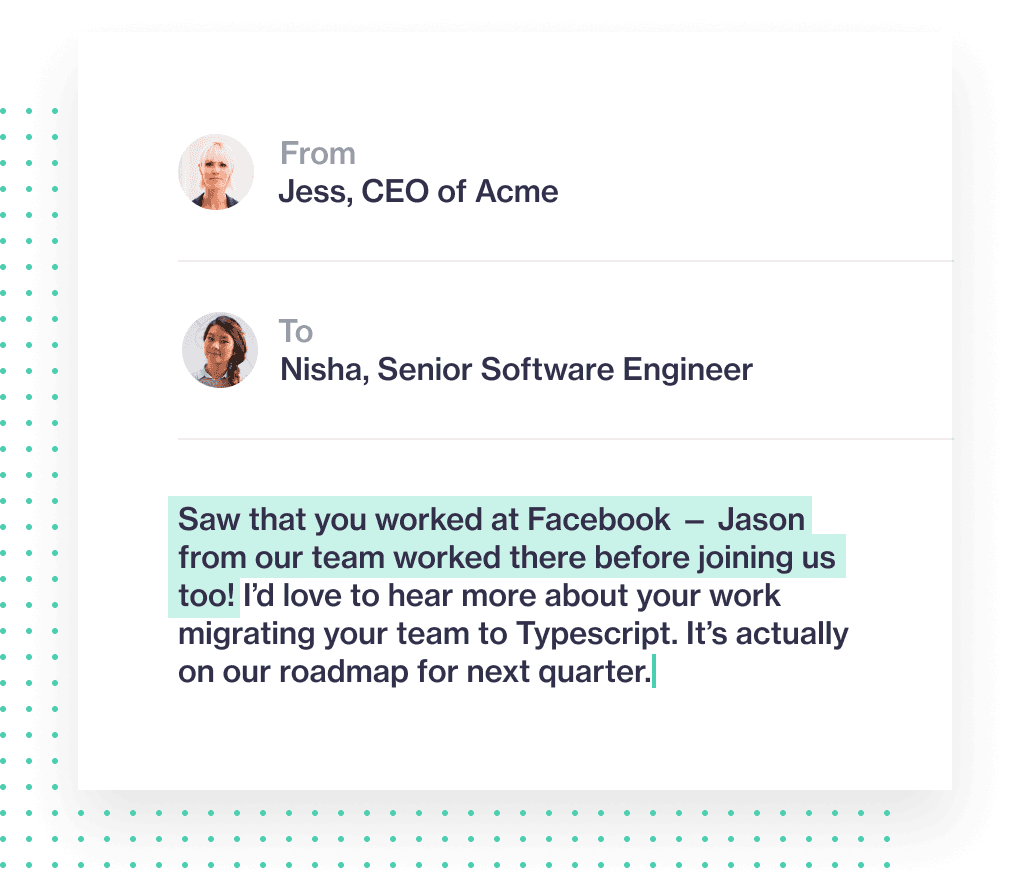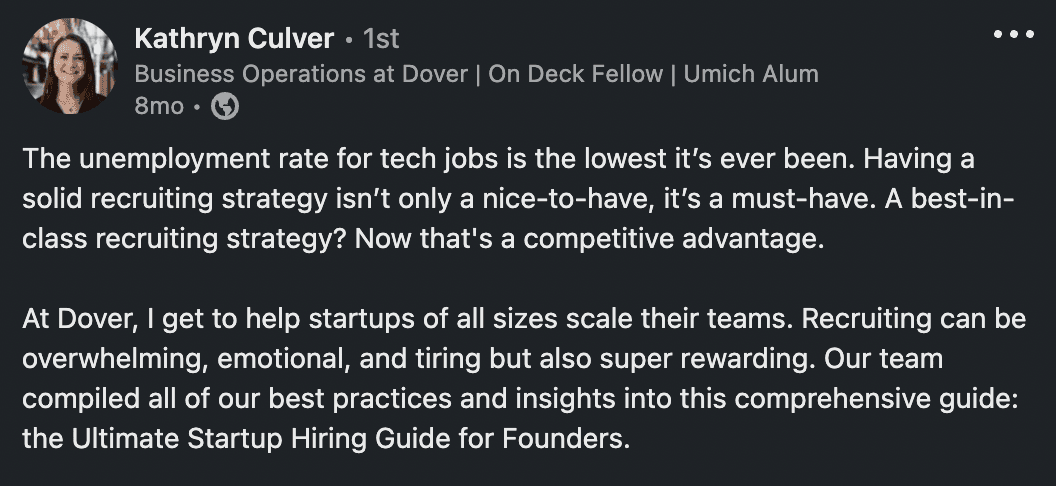How to source passive candidates in a crowded talent market

Magda Cychowski
April 26, 2023
•
5 min

Here's a surprising statistic: if you're only posting on job boards, then that's exactly what's happening: you're missing out on nearly 70% of the global workforce. In today's crowded market, passive talent sourcing is the only way to find top talent, hit diversity goals, and have a consistent top of funnel.
What is passive candidate sourcing?
Passive candidate sourcing is the strategy of proactively targeting and engaging candidates who may be open to new opportunities but are not actively looking for a job. It typically involves identifying passive candidates through their digital footprints — from their LinkedIn profiles to their blogs, publications, and other digital properties — in order to initiate contact and inspire them to apply or interview for an open role.
The difference between active and passive candidates
Active candidates are job seekers who are actively looking for a new job and are taking steps to find one, such as submitting applications, networking, and attending job fairs. Passive candidates, on the other hand, are not actively looking for a new job but might be open to considering new opportunities if they arise.
Passive candidates might include people who are satisfied in their current job but are open to hearing about other opportunities, as well as those who are not actively looking for a job but might be open to considering one if the right opportunity comes along. They're also more likely to be qualified candidates, or at least fit more of your requirements, since you're seeking them out.
How to find passive candidates
1. Leverage social media platforms
Gone are the days of advertising on LinkedIn to find candidates. With 52% of hiring managers finding passive candidate hiring less effective due to LinkedIn being oversaturated, it may be beneficial to diversify your social recruiting approach.
And while most companies are on social, they're not utilizing social media recruiting to its full potential. Here are a few ways to get started:
Post all jobs to social media. Or, at the very least, post that you're hiring and consider promoting the post so candidates who come across your profile will know you're actively recruiting.
Use hashtags to target specific audiences,especially for the roles you're hiring for.
Share employer brand content. 48% of job seekers rank social media as the #1 place they go to research any “deal breakers” such as lower pay, less work-life balance, and lack of workplace flexibility. Post pictures of your team, or testimonials from staff members.
Post on behalf of recruiters’ social profiles. Or have recruiters create unique profiles for your company where they can recruit for their open reqs.

2. Invest in automation tools in your hiring process
Automation is the future of passive recruitment, and it's key to providing an exceptional candidate experience in the passive sourcing process. In a talented market, speed is everything.
Since passive talent isn't actively looking, they won't be motivated to respond unless you either have incredibly enticing recruiting emails or continuously nurture your relationship with them (similar to a sales prospect). Automation software, like Dover, can make sure you send timely follow-ups, create talent pools of candidates to reach out to later who responded "not yet", and automate scheduling so you limit dropoff or losing out to other offers.
3. Establish a referral program
Referral-based recruiting has long been popular, and for a valid reason — 78% of recruiters have found their most appropriate candidates through referrals from current employees.
To establish an employee referral program you'll need to:
Create an outline of the rules of your program and document how it works. For example, you should think through: What kind of process do employees go through to make a referral? What kind of incentive is involved? How will you update your website with this added benefit?
Next, set up an incentive structure for referring successful new hires, such as bonuses or rewards.
Finally, track and monitor the efficacy of the referral program by reviewing metrics such as timing from when the person was referred to when they joined.
How to engage passive candidates
1. Stress company culture and candidate growth potential
87 percent of Millennials say career growth and developmental opportunities are important to them in a job, and nearly 80 percent look for people and culture fit with employers before they look for career potential. This is especially true for passive candidates, who are theoretically happy in their current positions and would need to be sold on more than salary alone.
For passive candidates, outlining your company culture, making sure your employer brand is up to par, and outlining their growth potential are the most important things to convey in your initial outreach.
2. Send personalized sourcing emails to prospective candidates
We've all seen the horrifying screenshots of mass recruiting emails gone wrong — using the wrong candidate name, or buggy personalization tokens that call out the wrong parts of a candidate's profile. In a crowded recruiting market, candidates can sniff out what's authentic from what's not — that's why personalization is crucial.
On Dover's platform, we give users the option to automatically generate personalized sentences for candidates using key skills that overlap with your role's requirements. After analyzing more than 6,000 candidate touchpoints across personalized vs. non-personalized outreach, we found that personalization increased interest in a role by 10-30%. That's even if the candidate responded as "not interested" to another company's outreach.
And, even if a candidate isn't actively looking to make a change, they're more likely to keep you in mind for future career moves, meaning you'll see increasing returns over time.

3. Build employee ambassadors and a strong brand in your industry
Employer branding doesn't have to be a one-person job: enlist the help of eager team members or those with strong personal brands to promote your content on their personal profiles to see greater ROI — content shared by employees receives 8x more engagement than content shared by brand channels, which means you can more easily gain visibility over more-established brands or competitors.
Though it may feel uncomfortable to ask employees to repost your content, half of employed Americans say they’d be willing to share their company’s social media content to their own social channels. 30% of employees say they already have.
An easy way to solve this is to enlist different teams when the content is relevant to them: 24% of those surveyed say they would be more likely to share company social media if they had a direct connection to the content (i.e. it was related to the work they do)
And if you provide templated language for people to use or edit, they're 27% more likely to post content to their personal profile.

Learn more about how Dover can help you source top talent and increase response rates by nearly 30%.
Kickstart recruiting with Dover's Recruiting Partners
